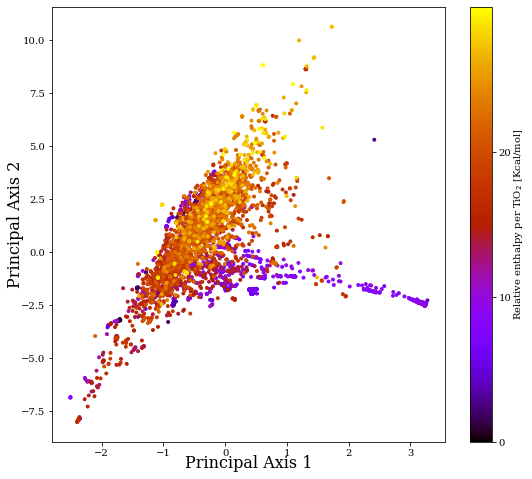How-to: use the asaplib library¶
Example on quick analyisis of atomic coordinates using a SOAP based metric¶
import numpy as np
%matplotlib inline
import asaplib
load structures¶
from asaplib.data import ASAPXYZ
asapxyz = ASAPXYZ('P-20GPa/result-complete/combined.xyz', periodic=True) # periodic=False otherwise
# load the tags (optional, you can use these to annotate the structures)
tags = np.loadtxt("P-20GPa/result-complete/ranking-complete", dtype="str")
# import some reference order parameter for the structures
enthalpy = np.array(tags[:,3],float)
compute SOAP descriptors¶
# specify the parameters
soap_spec = {'soap1': {'type': 'SOAP',
'cutoff': 4.0,
'n': 6,
'l': 6,
'atom_gaussian_width': 0.5,
'crossover': False,
'rbf': 'gto'
}
}
reducer_spec = {'reducer1': {
'reducer_type': 'average', # [average], [sum], [moment_average], [moment_sum]
'element_wise': False}
}
desc_spec = {'avgsoap': {
'atomic_descriptor': soap_spec,
'reducer_function': reducer_spec}
}
# compute atomic descriptors only
asapxyz.compute_atomic_descriptors(desc_spec_dict=soap_spec,
sbs=[],
tag='tio2-atomic',
n_process=1)
# if you want to retrieve the atomic descriptors computed earlier
dm_atomic = asapxyz.fetch_computed_atomic_descriptors(['soap1'])
# compute descriptors for the whole structures
asapxyz.compute_global_descriptors(desc_spec_dict=desc_spec,
sbs=[],
keep_atomic=False, # set to True to keep the atomic descriptors
tag='tio2',
n_process=4)
# can use asapxyz.fetch_computed_atomic_descriptors(['soap1']) if keep_atomic=True
Build a kernel Matrix¶
reduce_dict = {}
reduce_dict['kpca'] = {"type": 'SPARSE_KPCA',
'parameter':{"n_components": 10,
"n_sparse": -1, # no sparsification
"kernel": {"first_kernel": {"type": 'linear'}}}}
kernel PCA on environmental similarity¶
from asaplib.reducedim import Dimension_Reducers
dreducer = Dimension_Reducers(reduce_dict)
dm = asapxyz.fetch_computed_descriptors(['avgsoap'])
proj = dreducer.fit_transform(dm)
Plot the result¶
from asaplib.plot import Plotters
fig_spec = { 'outfile': None,
'show': False,
'title': None,
'size': [8*1.1, 8],
'cmap': 'gnuplot',
'components':{
'first_p': {'type': 'scatter', 'clabel': 'Relative enthalpy per TiO$_2$ [Kcal/mol]',
'vmin':None, 'vmax': None}
#'second_p': {"type": 'annotate', 'adtext': False} # for annotation
}
}
asap_plot = Plotters(fig_spec)
plotcolor = enthalpy[:]
asap_plot.plot(proj[:, [1,0]], plotcolor)
# one can use asap_plot.plot(proj[:, [1,0]], plotcolor, tags) to annotate the structures using the tags
Using scatter plot ...
